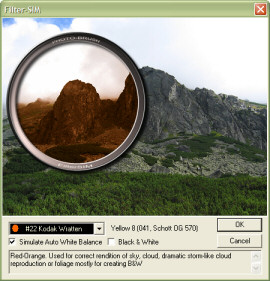Menu: Adjust -> Filter-SIM
This filter simulates the real-life usage of CC and Light Balancing glass or gel filters with the normal photographic film or digital camera.

Background
Each type of negative/positive film is factory-optimized for a special “color temperature” of the light measured in Kelvin.
If the color temperature of the light conditions match the color temperature of the film, then we will get picture with just the right colors. However, if we use this film in different light conditions (pretty often) - then the colors will be - well, different than those in real life.
For example, use a daylight film (most films you buy) in tungsten light (which is ~ 3200° Kelvin) without a flash and your pictures will come out reddish...
Even during the day the color temperature changes rapidly: dusk is at 2000° K, overcast 4000° K, bright noon 7000° K ...
Professionals need the best results so they use CC (Color Correction) filters to lower or raise the color temperature. If a pro has a film for daylight in his camera then for tungsten light, he will pull out a blue filter (80A) to raise the color temperature (filter 3200°K to 4100°K) and vice-versa. If he has a tungsten film in the camera and he wants to snap some shots in daylight, he will use an amber filter (for example 85B). And even the lights in a studio have known and written color temperature.
A subset of CC filters are Light Balancing filters. Such filters make a minor color temperature change and they are mostly used creatively to warm or cool a scene (filters such 81, 82, 2E and many others).
CC filters are of course still used - in studio photography or motion pictures to name just few.
For example 81A is very often used to add warm to skin tones.
How does it work?
Just select a filter type and the image will be shown with the filter on! You can also move the glass filter on the image.
Some filters are often used with B&W photography (for example, yellow filter to enhance skies). You can simulate this from your Color images by simply setting Black & white option.
What is the Wratten and the filter number?
Wratten is a brand name of Kodak and their filter numbering is quite common. Most of the other manufacturers adapted these numbers as well. If the filter is known by other numbering (Schott, etc.), this will be shown as well. Also a short description about the filter usage in professional photography is displayed.
Simulate Auto White Balance
In real life during the exposition your digital/film camera will try to auto compensate the lower light. On digital cameras the AWB (or color balance correction on film during developing) will also try to correct the color balance of the shot. For light balancing filters this option (default) will give you more natural looking and pleasant result.
What is with the dark or clear filter?
Filter for Example 18A is a transparent UV filter. It is included, but in fact the result can’t be properly simulated for obvious reasons - the filter is just blocking invisible UV radiation...
From the other hand filters such 87C are Infra Red filters - they are transparent only for IR light. Normal film wouldn't be able to take any pictures (you need IR film), but digital cameras are sensitive to IR light. (Point any remote control toward your digital camera and press few buttons on it - the display should see a light). Anyway this effect can't be simulated either because you don't have the IR information distinguished in the already taken image.
FilterSIM is also a very educational. You may not only warm or cool your digital images, but you will also learn the art of using real life filters.